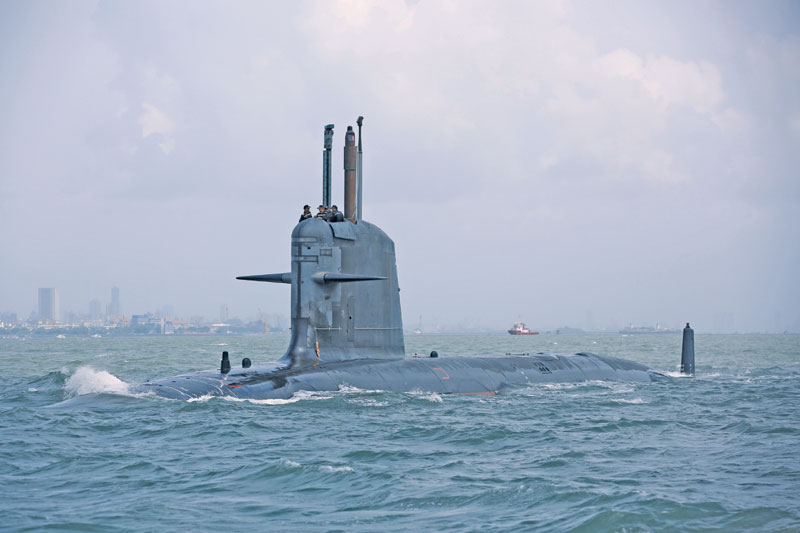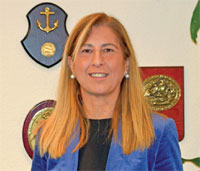MDL and L&T will be the Strategic Partners for P75-I submarine building programme
Palak Gupta
After a long delay, the Defence Acquisition Council (DAC) chaired by defence minister Rajnath Singh finally nominated two domestic shipyard companies — state-owned Mazagon Dock Shipbuilders Ltd (MDL) and private sector firm Larsen & Toubro (L&T) as Strategic Partners for the ambitious Project-75 India (Project 75-I) submarine building programme on 21 January 2020.

Project 75-I-class submarine irrefutably is one of the country’s longest delayed defence projects and it is a follow-on of Project 75 Kalvari-class submarines for the Indian Navy. This is the second project under the ministry of defence’s (MoD) Strategic Partnership (SP) model, the other being the procurement of 111 Naval Utility Helicopters (NUH).
In line with the government’s flagship ‘Make in India’ programme, SP model aims at promoting India as a manufacturing hub for defence equipment through transfer of niche technologies and higher Indigenous Content (IC).
Under this project, six new stealth submarines will be constructed in collaboration with global Original Equipment Manufacturers (OEMs), namely, France’s Naval Group, Spain’s Navantia, Russia’s Rubin Design Bureau (which will partake in the programme through Rosoboronexport), Germany’s ThyssenKrupp Marine Systems (TKMS) and South Korea’s Daewoo. The Rs 50,000 crore project is expected to provide impetus to the existing submarine design and manufacturing eco-system in the country via transfer of design and equipment technology along with the required skill sets.
The Indian SPs were shortlisted for their capability to integrate systems, expertise in shipbuilding domain and the financial strength. The global OEMs were primarily judged on their submarine design, Transfer of Technology (ToT) and IC criteria.
Navantia has offered S-80 plus-class submarine; Rubin Design Bureau brings the Amur 1650 submarine to the table; France is offering the Scorpene 2000; TKMS has pitched its HDW class 214 and Daewoo is offering its KSS-III.
“The S-80 plus represents a very recent and up-to-date baseline, and it is very close to the requirements of the Indian Navy. For this reason, the technical effort at this stage is minimum, and we are very much focused on other aspects such as the indigenisation of major equipment and material,” Navantia’s commercial and business development director Sofia Honrubia told FORCE.
The Spanish state-owned shipbuilding company’s collaboration with the Indian industry commenced with the Scorpene programme. Currently, it is all set to organise an industry day event in New Delhi through Navantia’s Indian office, details of which will shortly be announced.
“Navantia has a background of cooperation with the Indian industry which started with the Scorpene programme, and still remains. We are very keen to open the door to further cooperation in several areas, and for this purpose we are organising an industry day event in Delhi through the Navantia Indian office, to ensure that we propose a fully compliant solution which meets the requirements of the Indian Navy with the Indian industry. This event will be announced shortly, and all Indian suppliers shall be welcomed,” Honrubia added.
Navantia’s commercial and business development director explained that no existing sea proven submarine on the market today can fulfill the requirements of the P75-I submarine programme without passing through a substantial redesign and development phase.
“The requirement of the P75-I submarine programme is demanding and fall out of the standard. To our knowledge, no existing sea proven submarine on the market today can fulfill the requirements without passing through a substantial redesign and development phase,” she said. “Navantia bring to the table a robust design for a non-nuclear 3000-tonne submarine provided with state-of-the-art Air Independent Propulsion (AIP) systems. The S-80 plus has been developed with the support of Electric Boat, a reputed US submarine designer. The S-80 plus design turns out very close to the Indian requirements, therefore requiring minimum change and low risk. The construction of the first of the four S-80 plus submarines has progressed well and shall be launched by the end of 2020.”
The first unit will be afloat October 2020, entering into service in 2022.
According to Honrubia, the timeline for the P75-I fits nicely with the availability of the design team participating in the S-80 plus, and they will be introduced to the P75-I as achieving a seamless transition, taking advantage of lessons learned, modern software tools and 4.0 methodologies.
The company’s AIP system is based on a revolutionary hydrogen generation system from standard bio-ethanol which avoids highly processed consumables. Bio-ethanol is readily available in almost every country. The fuel cell has been developed in cooperation with Collins Aerospace, well known for their work with NASA in aerospace. The system has been subjected to extensive endurance and testing at a land base facility in Spain.

While the company did not provide the exact duration of time the submarine can remain underwater, saying it “is confidential and cannot be disclosed”, it hopes that its AIP will “highly contribute to enhance stealth capabilities and the Indian Navy’s maritime capability” and its undersea dominance from several foreign rivals.
However, according to a report in Spanish press written in July 2018, the success of the S-80 plus rests on the performance of its AIP system. It states, “If all goes well, the S-80 plus will be a highly competitive product in the conventional sub-market, ahead of the German 214. If things go wrong, it will become a failed project, as nobody will want to purchase such a big and indiscreet submarine.” The estimated cost of every S-80 plus reportedly will come close to Euro1 billion. FORCE could not independently verify the cost per unit.
You must be logged in to view this content.

